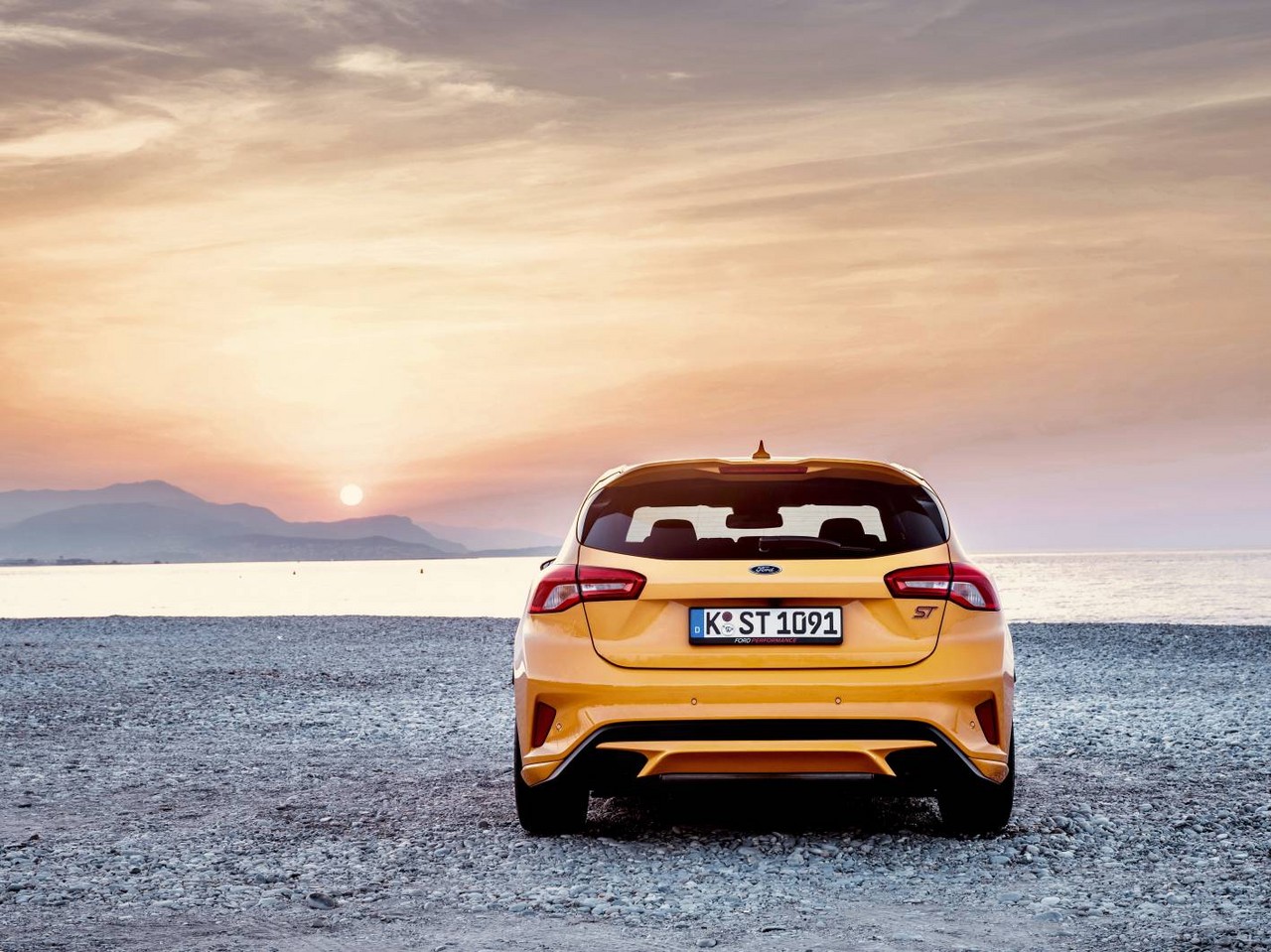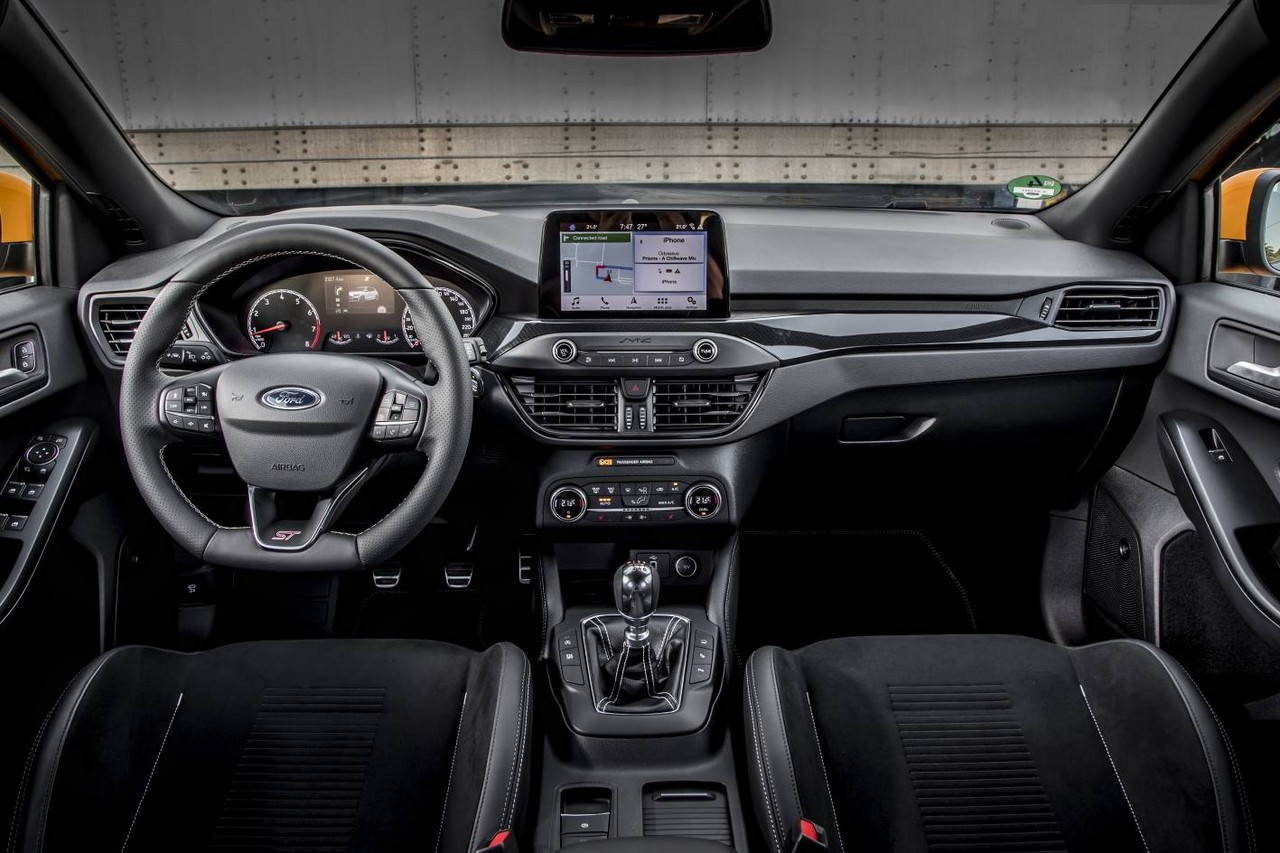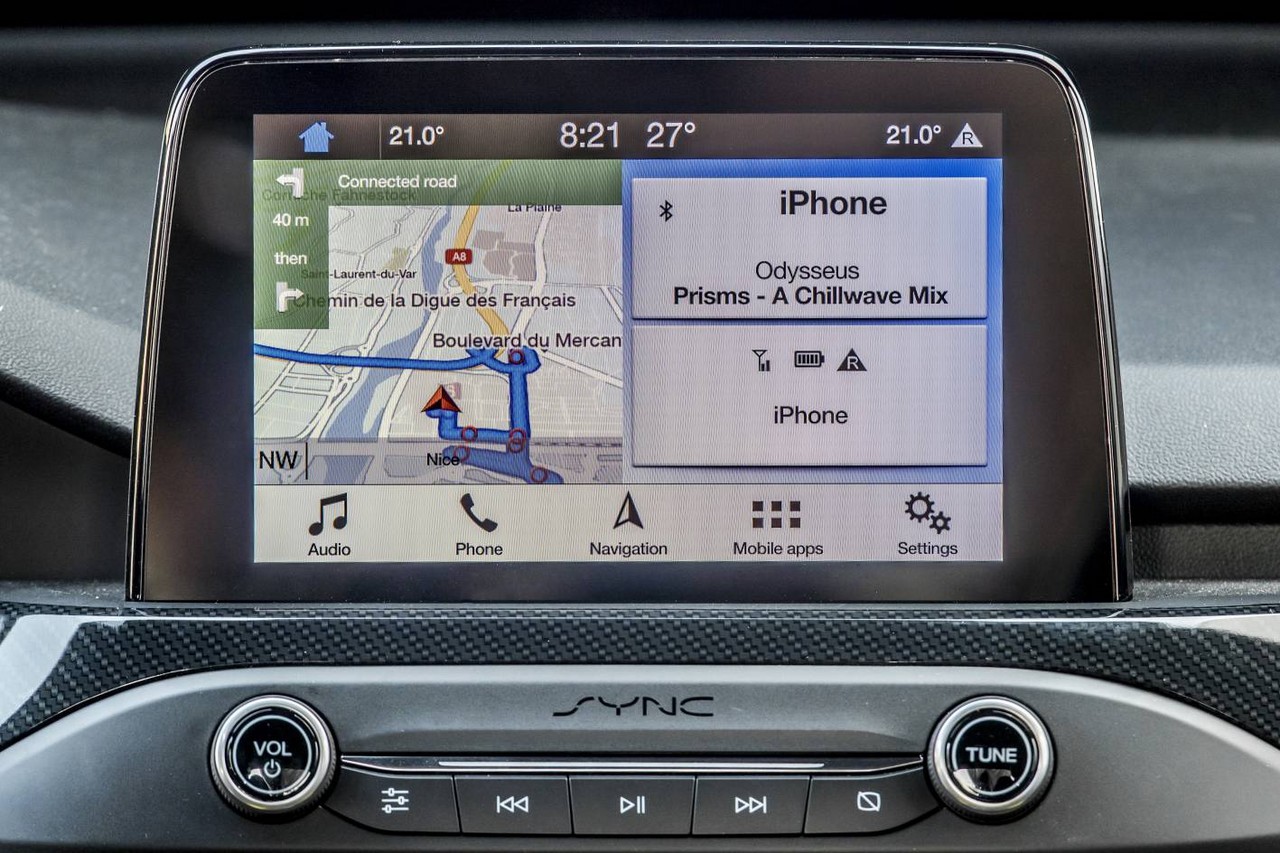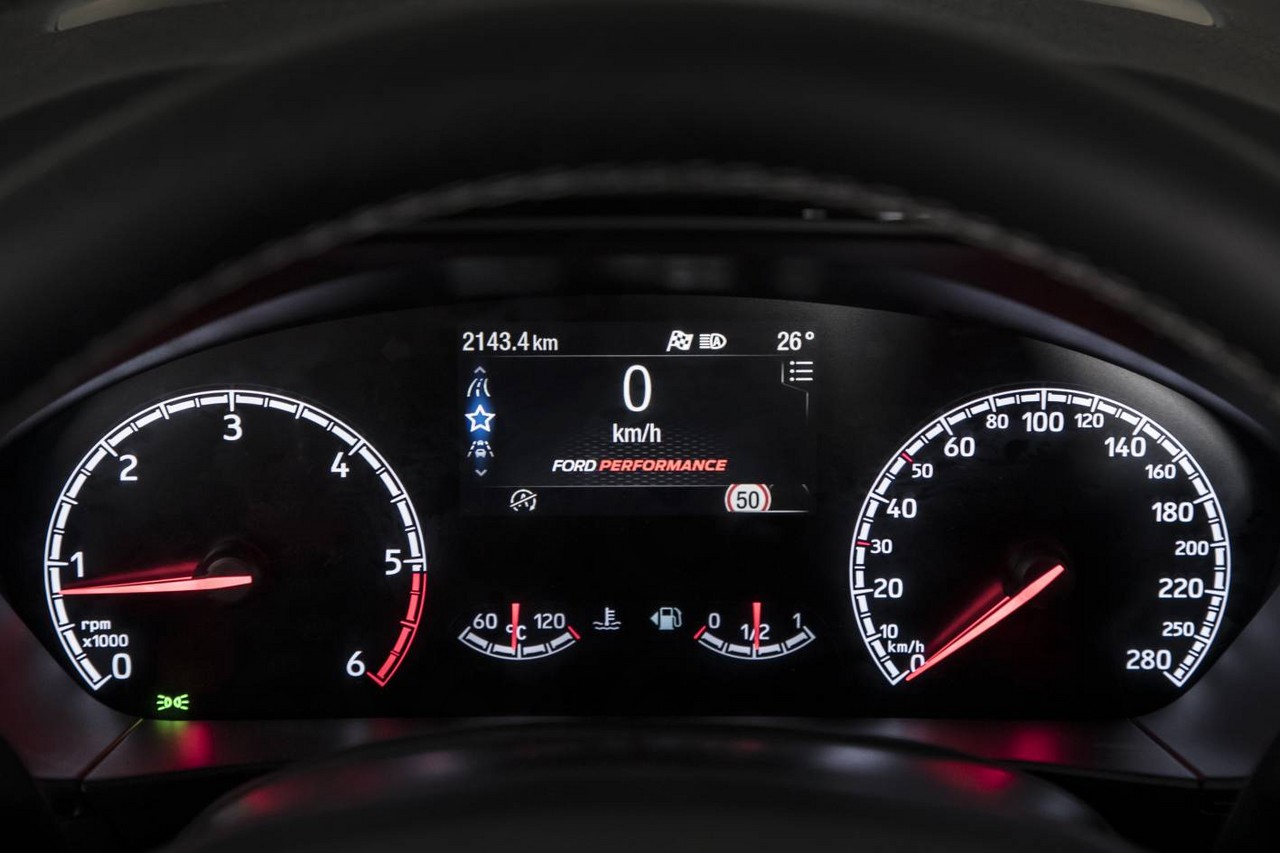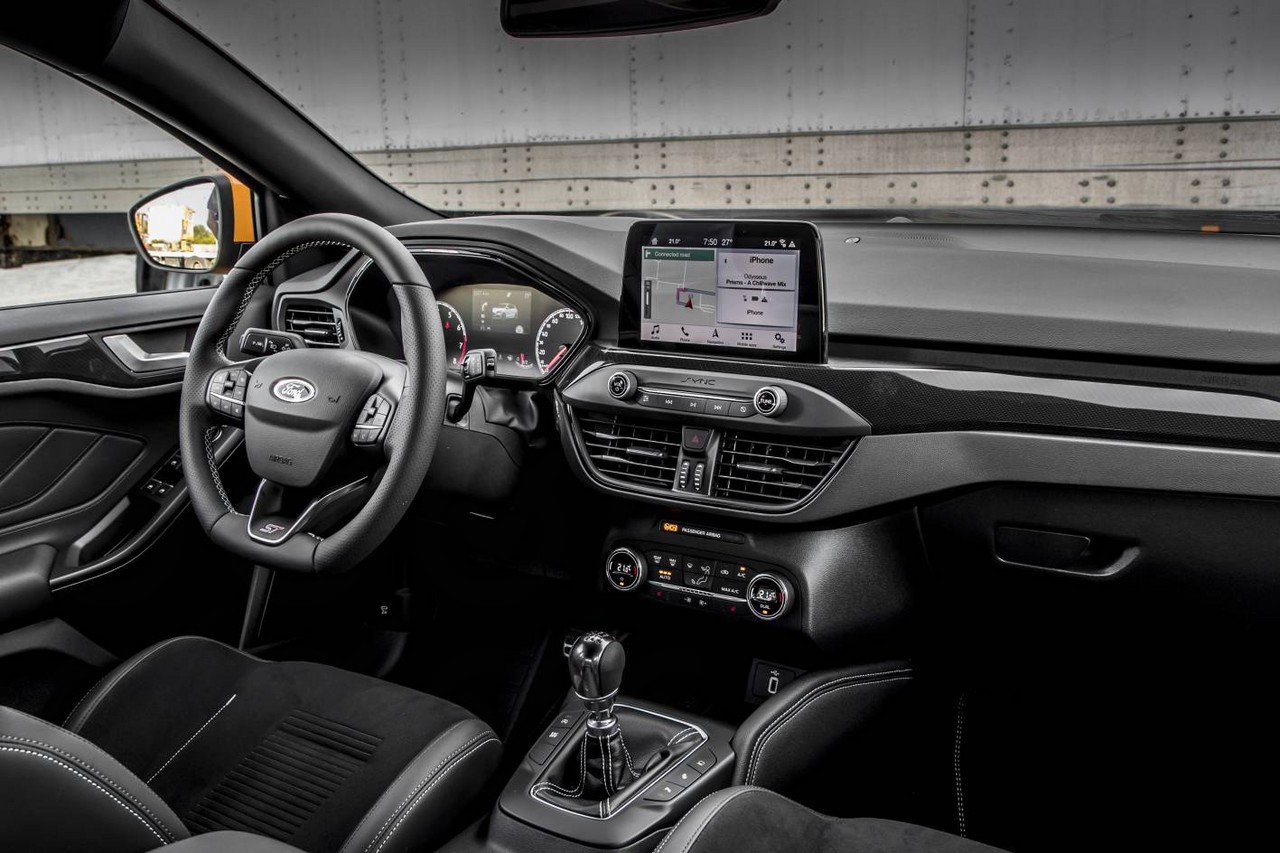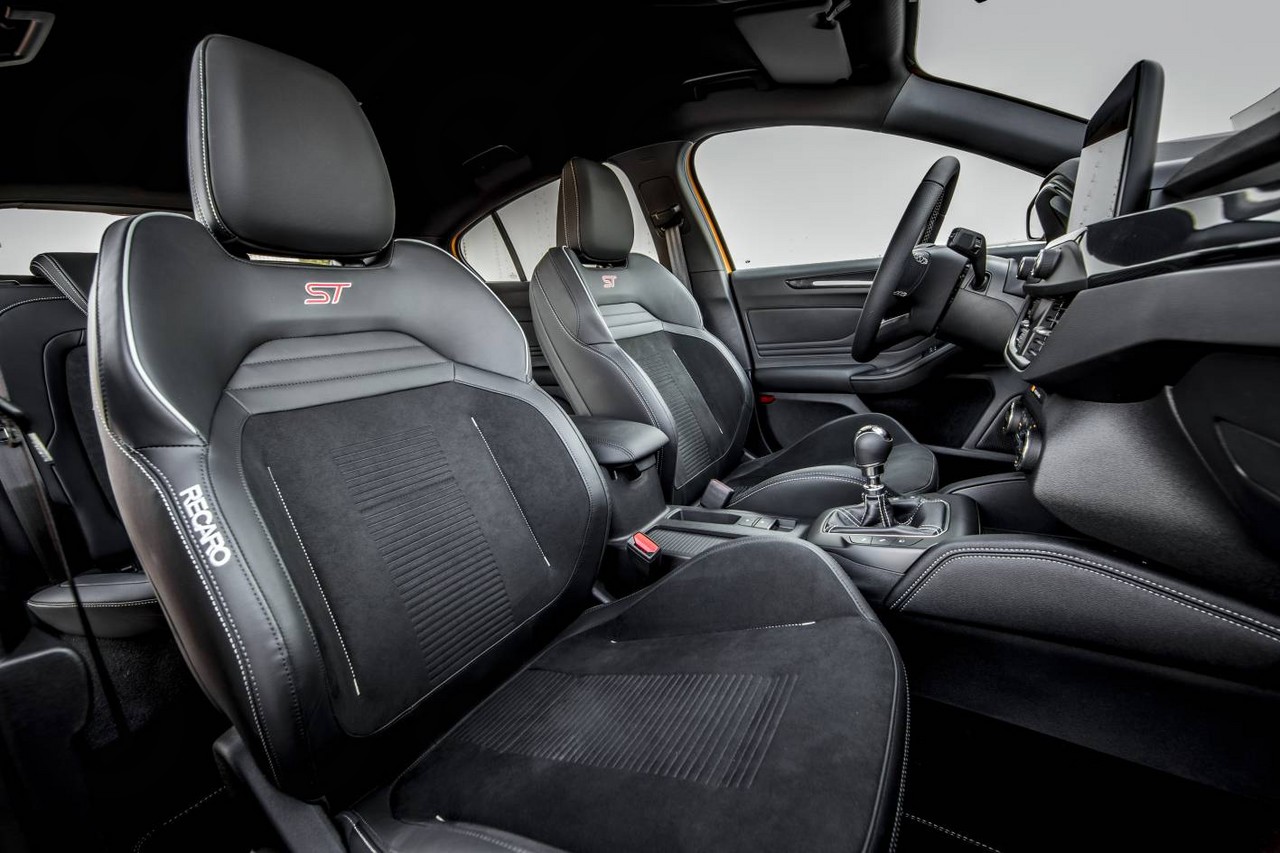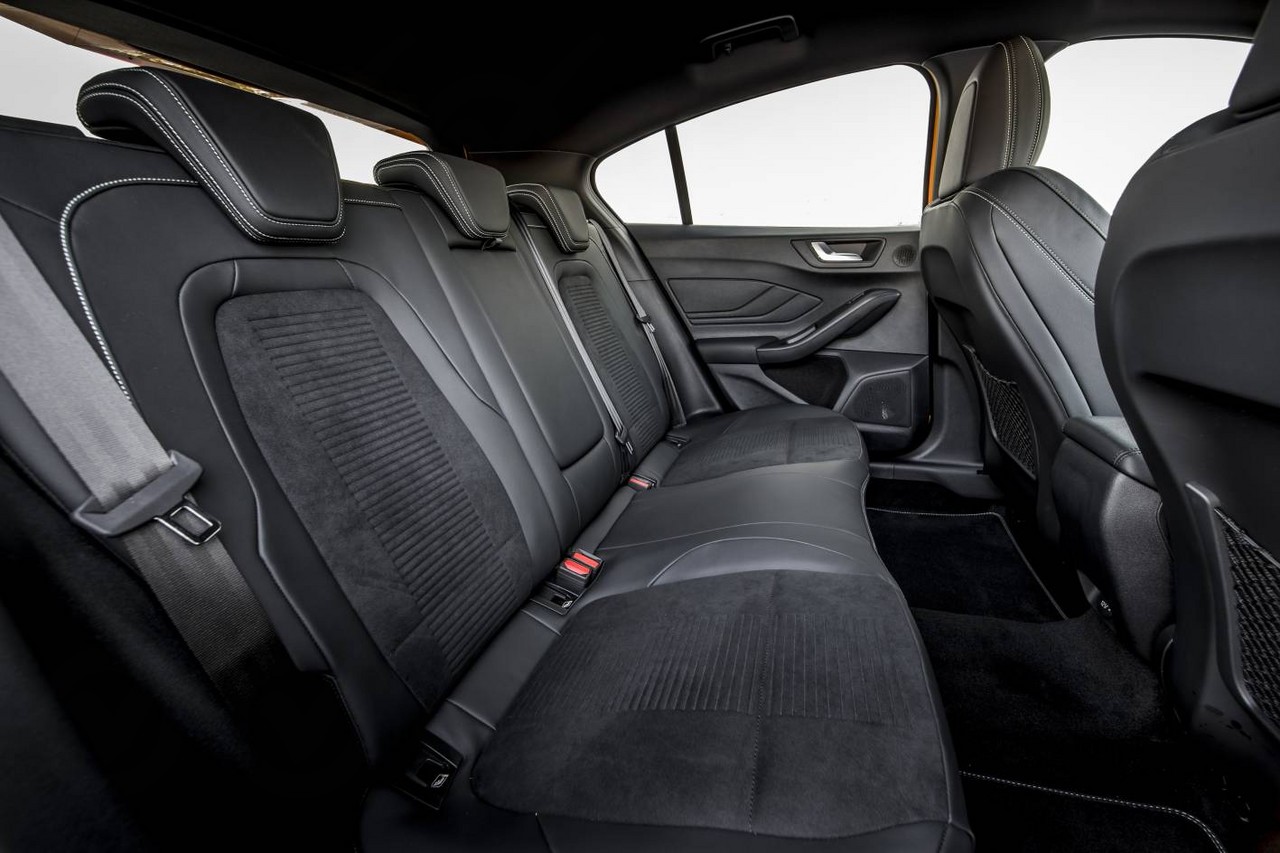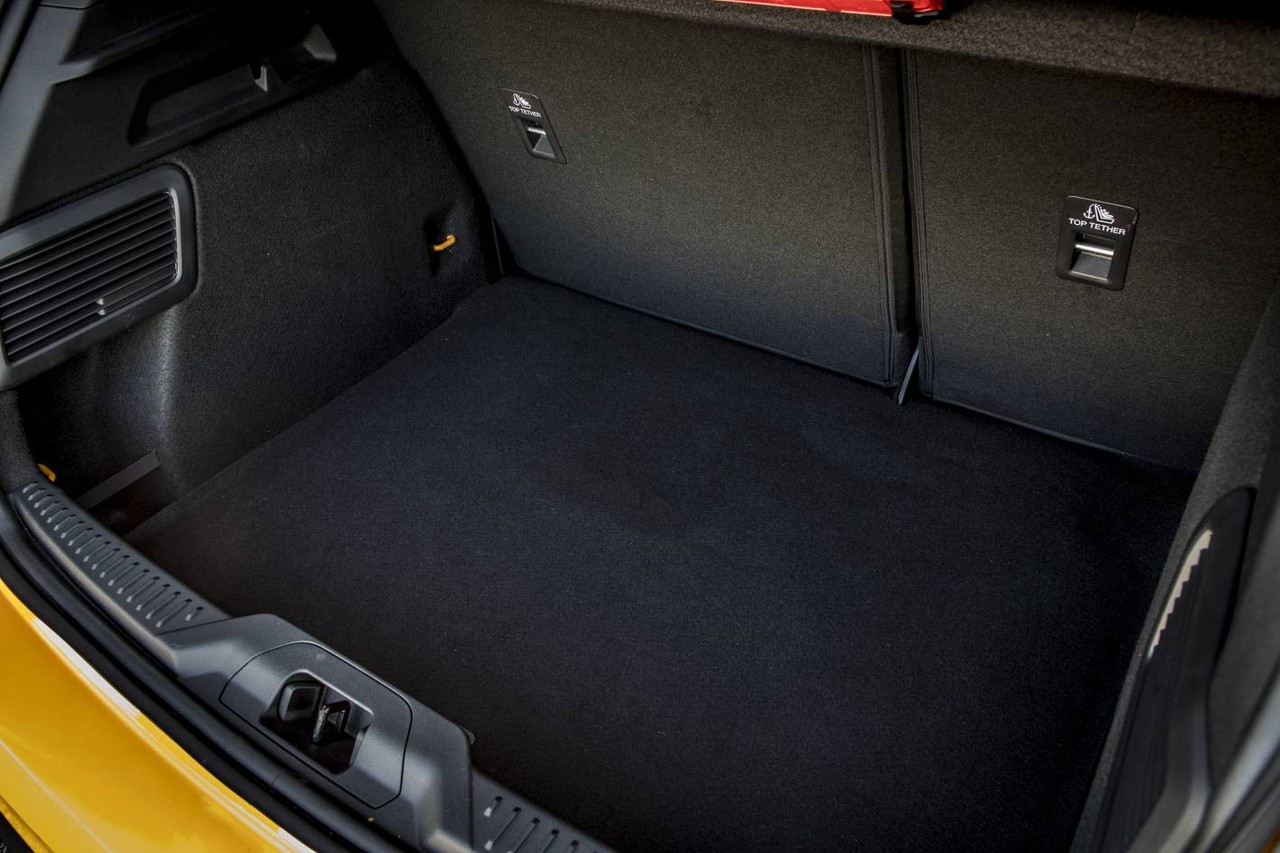
- 2.3-litre turbo engine delivers immense torque from 2500 rpm and revs freely
- Active safety technologies fitted as standard
- Electronically-controlled dampers contribute to impressive ride/handling balance
- Steering is accurate and direct
- Effective brakes
- Traffic sign-based speed limiter is great 99% of the time…
- … but not for time-specific speed limits
- Rear seats don’t fold completely flat
Overview
To be released in Australia in the first quarter of 2020, the Ford Mk.4 Focus ST is a five-door hot hatch. Manufactured in Saarlouis, Germany, the front-wheel drive Ford Mk.4 Focus ST is powered by a 2.3-litre turbocharged petrol engine that is mated to either six-speed manual or seven-speed automatic transmissions. Upon its release, both manual and automatic versions of the Focus ST will have a Manufacturer’s List Price of $44,690 (excludes on-road costs).
Focus ST: 2.3T ‘EcoBoost’ engine
The 2261 cc four-cylinder turbocharged petrol engine for the Focus ST has an aluminium cylinder block with cast iron liners, a cast iron crankshaft which had eight counterweights and rotated on five main bearings, an aluminium alloy cylinder head, a variable geometry twin-scroll turbocharger, an electronically actuated wastegate, forged steel connecting rods, double overhead camshafts with twin independent variable camshaft timing (Ford’s Ti-VCT), four valves per cylinder and direct fuel injection at up to 200 bar.
When the ‘Sport’ and ‘Track’ drive modes are selected, an anti-lag system keeps the throttle open when the driver lifts off the accelerator pedal to avoid the reversal of airflow from the turbocharger. This maintains compressor wheel speed so that boost pressure is available when the driver depresses the accelerator pedal again.
Transmissions
The six-speed manual transmission for the Focus ST has a rev-matching function which uses the engine’s electronic control system to briefly ‘blip’ the throttle as the driver engages a lower gear to match engine rotation speed to that of the gear being selected. The manual Focus ST is also equipped with a gearshift indicator light. With the six-speed manual transmission, the Focus ST can accelerate from rest to 100 km/h in 5.7 seconds.
The seven-speed automatic transmission features Ford’s ‘Adaptive Shift Scheduling’ which assesses individual driving styles and adjusts gearshift timing accordingly. The driver can also change gears via the steering wheel-mounted paddle shifters.
| Engine | Trans. | Peak power | Peak torque | |
|---|---|---|---|---|
| Focus ST | 2261 cc turbo petrol I4 | 6sp man., 7sp auto |
206 kW at 5500 rpm | 420 Nm at 3000-4000 rpm |
eLSD
The Ford Mk.4 Focus ST has an electronically-controlled limited-slip differential (eLSD) that is incorporated into the transmission. Developed by Borg Warner, the eLSD uses hydraulically activated clutches to limit engine torque to a wheel that has reduced traction on the road surface, and redistributes up to 100 per cent of available torque to the wheel with more traction. The eLSD can also pre-emptively adjust torque distribution using inputs from powertrain and vehicle dynamics, rather than responding to wheelspin.
Body and dimensions
The Ford Mk.4 Focus ST is underpinned by Ford’s ‘C2’ global architecture which is shared with the standard Ford Mk.4 Focus . The body features ultra-high strength boron steel that is produced at Ford’s Saarlouis plant using forty-metre furnaces with gas and magnetic induction. The furnaces heat boron steel plates to 930 degrees Celsius so that they can then be moulded by 1250 tonne presses. After water cooling, the boron steel plates are cut by a 3000 degree Celsius laser beam. Other production techniques for the Ford Focus ST include:
- A ‘form and pierce’ process that uses cameras to measure the optimal position of front-end mounting holes within tolerances of 0.1 mm. A second camera system monitors the position of the apparatus and can adjust to tolerances of 0.1 mm to account for expansion and contraction in changing temperatures. According to Ford, this process enables the front-end mounting holes to be positioned with an accuracy of 0.5 mm;
- In a Ford-first, laser-welding technology is used to produce wobble-welded seams; and,
- Tri-focal laser-brazing – which has an operating speed of 60 mm per second – is used for stronger and more precise joints between the roof and body sides.
To improve the stiffness of the rear structure, a wet extruded foam is inserted into the rear underbody cavity during the vehicle’s assembly (a process introduced for the Ford LZ Focus RS) – under the heat of the paint-drying process, this foam expands to increase local lateral rigidity.
Compared to the Ford Mk.3 Focus ST which it replaces, the Mk.4 Focus ST is 26 mm longer (at 4388 mm), 2 mm wider (1825 mm), 26 mm lower (1458 mm) and has a 52 mm longer wheelbase (2700 mm). With the six-speed manual transmission, the Mk.4 Focus ST has a kerb weight of 1508 kg (includes 75 kg driver).
Suspension
The Ford Mk.4 Focus has MacPherson strut front suspension and Short Long Arm (SLA) independent rear suspension. Compared to the standard Ford Mk.4 Focus, damping stiffness is increased by 20 per cent at the front and 13 per cent at the rear. Furthermore, the Focus ST has a 10 mm lower ride height.
As standard, the Focus ST is equipped with Ford’s ‘Continuously Controlled Damping’ (CCD) which monitors suspension, body, steering and braking inputs every 2 ms to adjust damping responses.
Steering
The Ford Mk.4 Focus ST has rack-and-pinion steering with a column-mounted electric motor for power assistance. The steering ratio is 11.6:1 and the steering wheel requires two turns from lock-to-lock. Furthermore, the Focus ST has a turning circle of 11.3 metres (kerb-to-kerb).
To reduce torque steer, the Focus ST has new ‘Steering Torque Disturbance Reduction’ software. Compared to the standard Ford Mk.4 Focus , the Focus ST has unique steering knuckle geometry whereby the rod attachment point is 9 mm further forward and 6.5 mm higher.
Safety equipment
Standard safety equipment for the Ford Focus ST includes dual front airbags, front seat-mounted side airbags, full-length curtain airbags (i.e. for front and rear occupants), ABS, electronic brake force distribution, brake assist, electronic stability control, traction control and front seatbelts with pre-tensioners and load limiters.
As standard, the Ford Focus ST is equipped with the following safety technologies –
- Pre-Collision Assist with Pedestrian and Cyclist Detection: can detect vehicles, people or cyclists that are on or around the road ahead, or who may cross the vehicle’s path. The system initially issues visual and audible warnings (‘Forward Collision Warning’), while the brakes are automatically applied if the driver does not respond and a collision is anticipated. By using illumination from the headlamps, the Pre-Collision system also operates at night;
- Adaptive Cruise Control (ACC) with stop & go and Lane-Centering: operating at speeds up to 200 km/h, ACC can adjust vehicle speed to maintain a safe distance from the vehicle ahead and up to the speed limit. Furthermore,
- The stop & go function can apply the brakes to reduce vehicle speed until stationary by applying up to 50 per cent of maximum braking force. If the vehicle is stationary for less than three (3) seconds, the Focus ST automatically accelerates when the road ahead cleares. For longer stationary durations, the driver can push a button on the steering wheel or depress the accelerator to move away; and,
- Lane Centering monitors road markings and can apply ‘gentle but discernible’ torque to the steering system to help drivers stay centred in their lane when ACC is active. The system also provides visual and audible warnings if it detectS a lack of steering wheel input from the driver;
- Blind Spot Information System: uses rear radar sensors to detect vehicles approaching from behind and in the driver’s blind spot. If detected, an icon illuminates in the door mirror on the side of the Ford Focus ST where the vehicle is detected;
- Lane Departure Warning and Lane Keeping Aid: operating at speeds above 60 km/h, the Lane Departure Warning can issue alerts if it detects that the vehicle is about to cross lane markings and the turn indicators have not been applied. Furthermore, Lane Keeping Aid can apply steering wheel torque to keep the vehicle in its lane;
- Intelligent Speed Assistance with Speed Sign Recognition and Speed Limiter: can detect the current speed limit based on signs and limit maximum vehicle speed;
- Cross Traffic Alert and Active Braking: when reversing out of a parking space, Cross Traffic Alert can alert the driver of approaching traffic that may cross the Focus ST’s path and automatically apply the brakes;
- Evasive Steering Assist: using the radar sensors and forward-facing camera to detect slower-moving and stationary vehicles, Evasive Steering Assist provides ‘steering support’ at city and motorway speeds to assist drivers in manoeuvring around a vehicle if a collision is imminent.
Emergency Assistance: in the event of a collision which deploys the vehicle’s airbags or fuel pump shut off, Emergency Assistance can use a synchronised mobile phone to deliver a voice message directly to 000 operators and keep the line open for hands-free communication; and, - Post-Collision Braking: after a collision, Post-Collision Braking automatically applies moderate brake pressure to reduce the likelihood and impact of a potential secondary collision.
Wheels, tyres and brakes
The Ford Mk.4 Focus ST has 18-inch alloy wheels and Michelin Pilot Sport 4S tyres. Furthermore, the Focus ST has 330 mm by 27 mm ventilated front brake discs with dual-piston calipers and 302 mm by 11 mm rear brake discs.
The Ford Focus ST is fitted with an Electric Brake Booster (EBB) which increases braking pressure faster than a hydraulic system for enhanced stopping and, according to Ford, provides more consistent pedal feel.
Features: Ford Focus ST
As standard, the Ford Focus ST is equipped with Ford’s ‘SYNC 3’ operating system, an eight-inch touchscreen, integrated satellite navigation with Traffic Message Channel and MapCare, Bluetooth mobile phone connectivity, voice control/voice recognition, Apple CarPlay and Android Auto smartphone integration, wireless smartphone charging, a ten speaker ‘B&O Play’ sound system and a digital radio tuner (DAB+).
Beyond this, standard features for the Ford Focus ST include climate control air conditioning, Recaro front seats, LED headlamps with daytime running lamps, directional LED fog lamps, dusk-sensing headlamps, rain-sensing wipers, a rear view camera, rear parking sensors, split/fold rear seats, a flat-bottom sports steering wheel, remote central locking, power adjustable and heated door mirrors, tilt and telescopic steering wheel adjustment, an electrochromatic rear view mirror, an electronic park brake, digital instruments, a 4.2-inch TFT colour instrument display and an immobiliser.
As standard, the Focus ST is also fitted with –
- Adaptive Front Lighting System with Predictive curve light and sign-based light: uses the forward-facing camera to monitor lane markings up to 65 metres ahead, enabling light from the headlamps to be angled into the corner for improved visibility on approach. Furthermore, the ability to interpret road signs can be used to optimise beam patterns so that the beam is widened at junctions and roundabouts;
- Auto High Beam: automatically engages high beam lighting when safe to do so;
- Glare-free high beam: masks high beam illumination to avoid dazzling other drivers;
- Electronic Sound Enhancement (ESE) to amplify engine and exhaust noise in Sport and Track modes; and,
- ‘Active Park Assist 2 with Park-Out Assist’: provides fully-automated parking manoeuvres, including gear selection, acceleration and braking. Once a suitable parking space is identified, the driver can initiate self-parking by engaging neutral and depressing a button on the centre console. Active Park Assist 2 then controls forward and reverse gear selection, throttle, braking and steering. Active Park Assist 2 can manoeuvre the Focus ST into spaces 1100 mm longer than the vehicle and on gradients up to 12 per cent. With the Park-Out Assist function, the vehicle can also autonomously exit parallel parking spaces.



